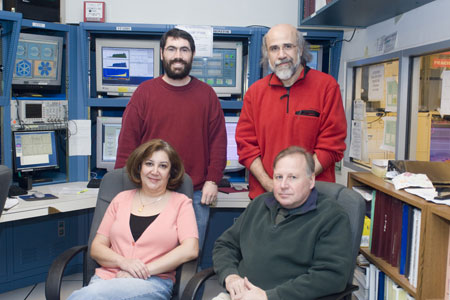2008 News Release
Particles Cling to Mass in the Nucleus

Researchers take a break in the Hall B Control Room. Shown are paper authors (back row, l-r) Mike Wood and Chaden Djalali and (front row) Rakhsha Nasseripour and Dennis Weygand.
The goal of the g7 experiment was to determine what happens to some common particles when they're exposed to the crowded environment found inside the nucleus of the atom. The first result from g7 was announced in a Physical Review Letters journal article published on Dec. 31. It concerns a particle called the rho meson.
The rho meson is similar to the proton found in the nucleus. Like the proton, the rho is built of quarks glued together by the strong force. However, it contains two quarks and a slew of strong-force "gluons," compared to a proton's three quarks and associated gluons.
The rho meson was one of the first particles discovered after protons and neutrons, and decades of research have pinned down the particle's properties, including its mass and lifetime. Knowing the properties of the rho meson so well means that researchers can observe how the rho changes when exposed to different environments.
Rakhsha Nasseripour, a postdoctoral researcher at George Washington University, presented a preliminary result from the experiment at the APS April Meeting in Jacksonville. Fla. She says that numerous theoretical models predicted that the properties of the rho meson would change inside a dense nucleus. "These models predicted some effects, such as a change in the mass," she explains.
To see if that were the case, the experimenters produced rho mesons inside dense nuclei, including carbon, iron and titanium. For comparison, they also produced rho mesons in a light nucleus, deuterium. The researchers found that the mass of the rho mesons did not change as a result of being in a dense nucleus. "If you do see the predicted effects, that means the theory worked. If you don't see the effects, that means that something's missing," Nasseripour explains. "So now, the result from this precision experiment provides some of the first data that can be used to constrain these theoretical models."
In addition to the rho, scientists were also interested in two other mesons: the omega and the phi. Mike Wood, a research scientist at the University of South Carolina, is leading the effort to interpret the data for that portion of the experiment, and that result is expected in the next year.
In the meantime, the g7 researchers are gearing up to make the case for another experimental run at JLab. "The improvement would be in looking at the momentum of the rho mesons. If we had enough data, we could categorize our rhos into low-momentum, slow-moving rhos and high-momentum, fast-moving rhos. And then we could make an even better comparison," Wood says.
He says theorists are particularly interested in the next result. "Since the announcement of the first result, the theoretical community is now trying to investigate momentum dependence of the properties of the mesons in medium. That's why we're proposing the second experiment," he says.
Dennis Weygand, a Jefferson Lab staff scientist and g7 experiment spokesperson, says studying these mesons further could provide researchers unique insight into the strong force, whose gluons build the mesons from quarks. The strong force also builds the protons and neutrons from quarks and binds protons and neutrons into the nucleus.
"We're trying to understand the properties of rho mesons in the nuclear medium, with quarks and gluons all around. The rho is interesting because it's produced and decays while it's in the medium, so you can take a snapshot of its state while it's in the nuclear medium," he says. "This is one of the few experiments that treats the strong force directly in its own environment."
The researchers all agree that improvements made during the first g7 run will also make the second run more efficient. In particular, Weygand says the researchers now have a better grasp on the "background," or instances in which particles other than the sought-after rho, omega, and phi mesons were produced.
"A lot of time was spent trying to understand the background. And eventually, we understood exactly what that background was. We're miles ahead of where we were for the first part of this experiment," he says.
The experimenters will make their case to the group that determines the experimental program at Jefferson Lab, the Program Advisory Committee, at the next PAC meeting in January.
Technical Paper: Search for medium modification of the ρ meson
R. Nasseripour, M. H. Wood, C. Djalali, D. P. Weygand, C. Tur, U. Mosel, P. Muehlich, CLAS Collaboration
Abstract: The photoproduction of vector mesons on various nuclei has been studied using the CLAS detector at Jefferson Laboratory. The vector mesons, ρ, ω, and φ, are observed via their decay to e+e-, in order to reduce the effects of final state interactions in the nucleus. Of particular interest are possible in-medium effects on the properties of the ρ meson. The ρ mass spectrum is extracted from the data on various nuclei, D2, C, Fe, and Ti. We observe no significant mass shift and some broadening consistent with expected collisional broadening for the ρ meson.
Jefferson Lab is managed and operated for the U.S. Department of Energy's Office of Science by Jefferson Science Associates, LLC, a joint venture between Southeastern Universities Research Association, Inc. and CSC Applied Technologies Division, LLC.

